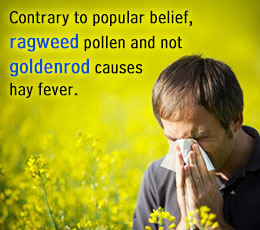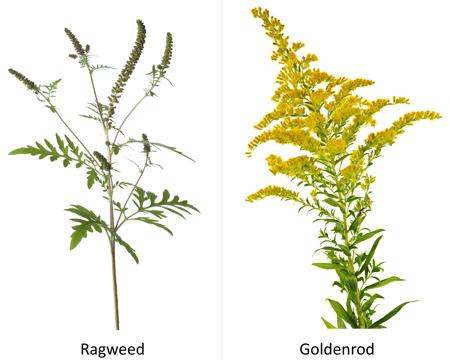Allergy sufferers are familiar with ragweed and goldenrod, as both these plants are notorious for causing hay fever. Lucky for them, as these plants are easy to identify. Buzzle provides you with handy tips on how to identify and differentiate between the two!

Rubber historyThe tires on the Model T given to Thomas Edison by his friend Henry Ford were made from goldenrod. Edison experimented to create a synthetic rubber to help compensate for wartime rubber shortages. Due to his efforts, extensive process development was conducted during World War II to commercialize goldenrod as a source of rubber.The onset of fall brings with it the onslaught of pollen allergies. While the main culprit is ragweed, goldenrod is incorrectly blamed for everyone's nasal affliction. When these plants are found growing side by side, goldenrod's bright flowers stand out against ragweed's pale blooms, causing it to be unfairly blamed for most pollen allergens. Although ragweed and goldenrod both belong to the aster family, Asteraceae, there the similarity ends. One is intentionally cultivated, and the other is a bothersome weed. The misplaced blame is generally due to a lack of proper identification.Characteristics of RagweedRagweed (Ambrosia artemisiifolia) is an annual broadleaf weed. Its common name is a reference to the ragged look of its leaves, while its scientific name refers to its foliage, whose shape resembles the artemisia plant. The leaves are divided pinnately or palmately into lobes. The height of the shrub ranges between 1 to 5 ft.The plant stem maybe erect, decumbent, or prostate. Many also grow from rhizomes. It is a monoecious plant that produces inflorescence in the form of a spike or a raceme made up of a combination of staminate flowers and pistillate clusters. To get rid of common ragweed, hand-pulling is the best method. They are easy to pull out since they have a shallow root system.
The plant is native to North America and can be found in every state in the U.S., except for Alaska. It is a ruderal species that thrives in disturbed habitats and is often found along roadsides.Characteristics of GoldenrodGoldenrod (Solidago canadensis) is a herbaceous perennial. It grows from woody caudices or rhizomes. It is easily recognized by its golden inflorescence with numerous small capitule. It has a slender stem and can grow to a length between 1-4 ft. Its leaves are alternately placed and are linear to lanceolate. The margins are serrated. Young goldenrod leaves are edible.The plant is prized as a garden plant in most parts of Europe, but is considered a weed by many in North America. Most types of goldenrod are indigenous to North America and grow as wildflowers in pastures and along roadsides.What are the Differences?

Ragweed
Flowers: They are green to yellow in color and appear in smaller formations on branched stems.
Pollination: Ragweed flowers lack the presence of nectar and depend primarily on the wind for pollination.
Pollen: Ragweed produces a huge amount of small-grained pollen.
Leaves: Leaves are smooth with deep lobes.
Stems: Ragweed stems are hairy and branched.
Height: They are 1 to 5 feet tall.
Plant Longevity: These plants are annuals.Goldenrod
Flowers: They are bright yellow and grow in large clusters resting on single stems.
Pollination: Goldenrod flowers contain nectar to attract pollinators.
Pollen: Goldenrod pollen is large in size.
Leaves: Goldenrod exhibits smooth, unlobed leaves.
Stems: Goldenrod has a single unbranched stem.
Height: They are 1 to 4 feet tall.
Plant Longevity: They are perennials.These tips will help in the identification and eradication of ragweed so that one may bid adieu and be free from pollen allergies.






 Rubber historyThe tires on the Model T given to Thomas Edison by his friend Henry Ford were made from goldenrod. Edison experimented to create a synthetic rubber to help compensate for wartime rubber shortages. Due to his efforts, extensive process development was conducted during World War II to commercialize goldenrod as a source of rubber.The onset of fall brings with it the onslaught of pollen allergies. While the main culprit is ragweed, goldenrod is incorrectly blamed for everyone's nasal affliction. When these plants are found growing side by side, goldenrod's bright flowers stand out against ragweed's pale blooms, causing it to be unfairly blamed for most pollen allergens. Although ragweed and goldenrod both belong to the aster family, Asteraceae, there the similarity ends. One is intentionally cultivated, and the other is a bothersome weed. The misplaced blame is generally due to a lack of proper identification.Characteristics of RagweedRagweed (Ambrosia artemisiifolia) is an annual broadleaf weed. Its common name is a reference to the ragged look of its leaves, while its scientific name refers to its foliage, whose shape resembles the artemisia plant. The leaves are divided pinnately or palmately into lobes. The height of the shrub ranges between 1 to 5 ft.The plant stem maybe erect, decumbent, or prostate. Many also grow from rhizomes. It is a monoecious plant that produces inflorescence in the form of a spike or a raceme made up of a combination of staminate flowers and pistillate clusters. To get rid of common ragweed, hand-pulling is the best method. They are easy to pull out since they have a shallow root system.
Rubber historyThe tires on the Model T given to Thomas Edison by his friend Henry Ford were made from goldenrod. Edison experimented to create a synthetic rubber to help compensate for wartime rubber shortages. Due to his efforts, extensive process development was conducted during World War II to commercialize goldenrod as a source of rubber.The onset of fall brings with it the onslaught of pollen allergies. While the main culprit is ragweed, goldenrod is incorrectly blamed for everyone's nasal affliction. When these plants are found growing side by side, goldenrod's bright flowers stand out against ragweed's pale blooms, causing it to be unfairly blamed for most pollen allergens. Although ragweed and goldenrod both belong to the aster family, Asteraceae, there the similarity ends. One is intentionally cultivated, and the other is a bothersome weed. The misplaced blame is generally due to a lack of proper identification.Characteristics of RagweedRagweed (Ambrosia artemisiifolia) is an annual broadleaf weed. Its common name is a reference to the ragged look of its leaves, while its scientific name refers to its foliage, whose shape resembles the artemisia plant. The leaves are divided pinnately or palmately into lobes. The height of the shrub ranges between 1 to 5 ft.The plant stem maybe erect, decumbent, or prostate. Many also grow from rhizomes. It is a monoecious plant that produces inflorescence in the form of a spike or a raceme made up of a combination of staminate flowers and pistillate clusters. To get rid of common ragweed, hand-pulling is the best method. They are easy to pull out since they have a shallow root system. RagweedFlowers: They are green to yellow in color and appear in smaller formations on branched stems.
RagweedFlowers: They are green to yellow in color and appear in smaller formations on branched stems.